|
|
|
|
|
|
|
Let it go
|
|
|
|
First of all, no, this is not about the latest Disney animated film. I’ve heard the song a kajillion times (in countless renditions) by now, but I have yet to see Frozen. However, people keep referencing “Let it go” everywhere I go… so there it is — blog title! Let it go.
Those three words do come in handy. A lot.
They were particularly appropriate last weekend, when I decided spontaneously to try sumi-e. On a whim, I decided to sign up for a six-hour class on the traditional Japanese style ink wash painting to see if I could perhaps apply some aspects of the technique to my ceramics work.
Saturday morning rolled around and I found myself at a table, fighting with large pieces of rice paper. Probably not the best way to start an activity centered around calm concentration. We were going to be painting flowers. Breath.

The knowledgable instructor kindly gave us some background information, since a couple of us had zero experience with it. Ink wash painting originated in China. Black ink is diluted to different degrees to produce varying tonalities on a very absorbent type of paper, called “xuan” or “washi” paper. The technique involves the use of spontaneous brush strokes, lines and dots, to convey a subject. The goal of sumi-e is to capture the essence of something rather than to produce an exact likeness. Stated another way, the subject is expressed using as few strokes as possible.
I learned some other things in those six hours:
1) It’s a lot harder than it looks.
2) I can’t paint tulips for beans.
3) “Let it go!”
Let’s expound on that last one. For me, one of the most difficult parts of this activity was to be comfortable with imprecision. As mentioned above, an important component of this type of expressive painting is spontaneity in the brush strokes. Translated, that pretty much means there is very little planning… or, to a beginner like me, control. Every brush stroke is visible on the xuan paper, so there is no “going back” to correct any mistakes. Once the brush hits the paper, you’ve committed to the stroke. In trying to evoke the spirit of the camellia (or the tulip or the daffodil), I had to be rather loose on the details. Thankfully, I wasn’t the only one who found it hard to strike that fine balance between letting the brush move freely and applying pressure deliberately. At one point, another student sighed, “Let it go!” And there it was, the realization that sometimes we need to let go of our need for control over every stroke and every detail, to allow ourselves to be moved. (I reflected on it outside of the painting context. How often in life do we get hung up on unimportant details? Can we let go enough to capture the essence of a moment?)
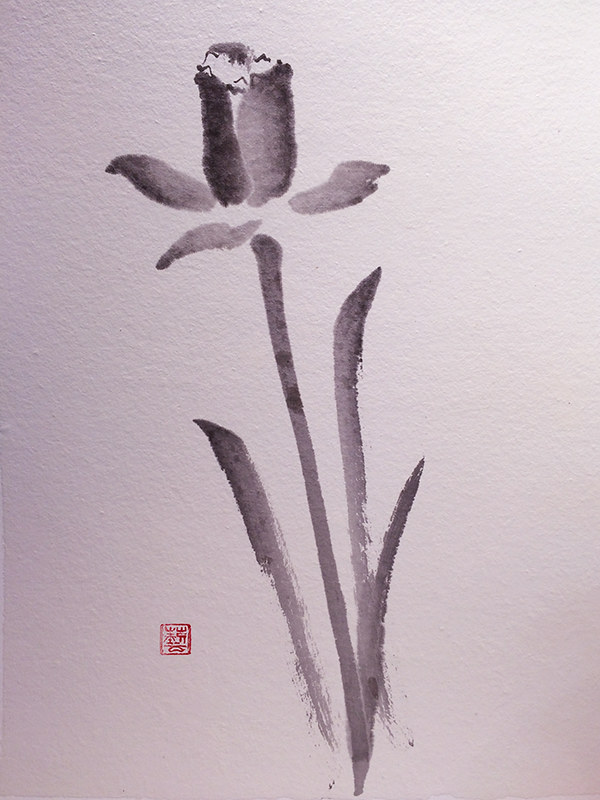
Although ink wash style painting has been applied to traditional Chinese blue and white ceramics, the style of “qinghua” painting I learned is much more detailed, and therefore, precise. Having said that, I have adapted the technique to my own style, choosing to use much fewer strokes and much cuter subject matters. Nevertheless, I plan my painting. While I don’t think I will be using sumi-e on my pots just yet, this exercise might just make me loosen up a bit!
|
|
|
|
|
|
|
|
|
|
|
|
Introducing… The Raindrop
|
|
|
|

Since it has been raining so much these past few days and there is no sign of it stopping anytime soon, I thought this would be an apt time to introduce The Raindrop.
The raindrop motif is a recurring one for me. I started playing around with it when my husband and I first decided to move back to North America after a couple of years in Shanghai, China. Specifically, we decided to move to Seattle, known commonly as the “rainy city” – so I decided to make the most of it and have some fun with raindrops.
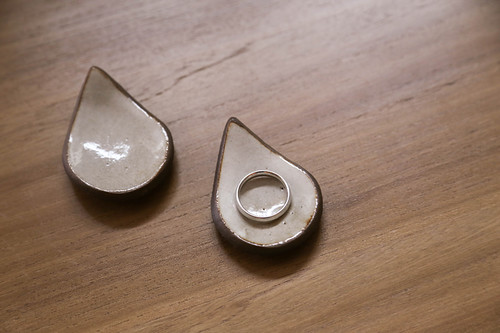
Once I started playing with the shape, I found that the curves were fun to paint and afforded a great way to practice my fine brush control. I also enjoy putting expressive faces on some of the raindrops to give them a touch of whimsy and mischief.
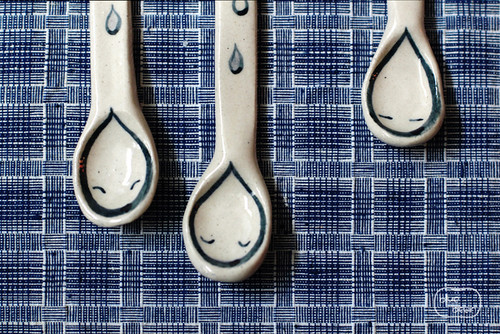
On particularly rainy days, you can find me curling up with a book in one hand and my little raindrop mug full of hot tea in the other.
(The items in the 2nd and 3rd photos, as well as other raindrop pieces, are currently in my Etsy shop.)
|
|
|
|
|
|
|
|
|
|
|
|
Liking mistakes
|
|
|
|
Oops… just realized I had a bit of a blogging lapse there. I’ve been having a couple of not-so-great days in the studio — stumbling around, making mistakes, feeling slightly “off.” My main frustrations are with learning to use a different clay and, perhaps more importantly, trying to figure out what I want to focus on creatively.
I stumbled across the following video of Chris Staley (Penn State Laureate 2012-2013) a few weeks ago. I found it very moving and thought this would be a fitting time to share it.
There are a couple parts that really resonated with me. Chris talks about how things are all interconnected and about life as a matter of heart. He gets quite choked up as he talks about how life is more than finding ways to validate ourselves: “Life is so much more than that… life is about feelings, and emotions and how we connect with one another.”
As to creativity, he discusses the “craftsmanship of risk” — the reality that when we make something with our hands we don’t know what our hands are going to do, that there is a “degree of unpredictability.” I think he poignantly encapsulates the whole idea of handmade creative work. Even the act of painting a line may not turn out the way we intend or expect it to. This unpredictability is the beautiful result of our bodies being made of hundreds of thousands of neurons that must coordinate in order for every action to take place. Even if my hands are being tasked by my brain to carefully paint a thin line, my legs have to cooperate and stay still. As such, a tiny jerk of the knee and my line goes askew. It’s because I’m human.
Mistakes are humanizing. We need not let them paralyze us. They are part of the human story. And sometimes our stories get poured into the objects we make.
“In some small way… all the cups and all the pots have a story. They’re more than just objects… they’ve been touched by the people that made them and obviously, in some way, they have touched our lives by using them everyday.” - Chris Staley
|
|
|
|
|
|
|
|
|
|
|
|
A year after Jingdezhen
|
|
|
|
About this time last year, I was halfway across the world, in Jingdezhen, China. I had made a last-minute decision to join a friend on a road trip to the “porcelain capital” — he to do a soda firing, I to see how the city would inspire me once more.
I still recall how cool it was to observe the changing landscape as we drove out of Shanghai and through the outskirts into a different province. As it turned out, I got my inspiration well before we arrived in Jingdezhen.

So much has happened since that last trip to Jingdezhen, but some of the most memorable moments during my time in China come from that place.
|
|
|
|
|
|
|
|
|
|
|
|
The original Rope Series by the Jōmon
|
|
|
|
Last week, I introduced the blue bean studio Rope Series. So what better time than now to talk about the *original* Rope pottery?
Before the blue bean studio Rope Series, there was Jōmon pottery.
When I first started focusing on using rope to texture and decorate my pieces, I was told that it had been done before. Of course, I wasn’t surprised to hear that; after all, most ideas are not entirely new and are birthed out of other existing ideas.
But then I looked deeper into the matter and discovered that not only had it been done before, it had been done on some of the oldest pots ever discovered anywhere in the world.
The pottery I am referring to date as far back as 14,000 BC (that’s OLD!) and come from Aomori in northern Japan. These ancient pottery fragments, called “Jōmon” ware, were first discovered near Tokyo in 1877.
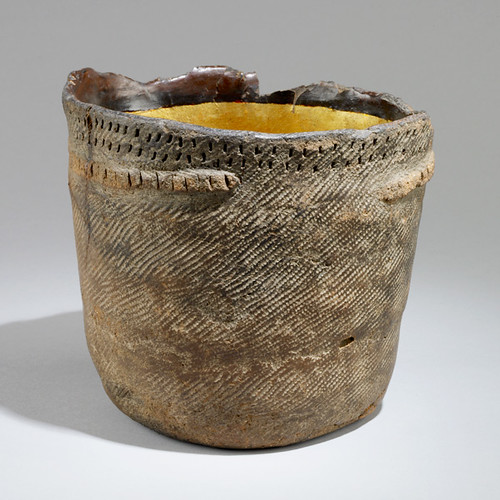
The term “Jōmon” (縄文) means “rope-patterned” in Japanese, and describes the characteristic twisted cord patterns impressed on to the surface of the clay. An entire period in the prehistory of Japan, the Jōmon Period, lasting from around 14,000 to 300 BC, is named after this style of pottery, which was produced throughout that time. The very long Jōmon Period is further divided into six phases.
The Jōmon peoples have been described as hunter-gatherers who later became semi-sedentary. The typically small vessels associated with them were probably used to boil and eat food. As the people settled into more sedentary lifestyles, their vessels increased in size. The pottery produced during the Jōmon period has been classified into about seventy different styles, with additional regional variations.
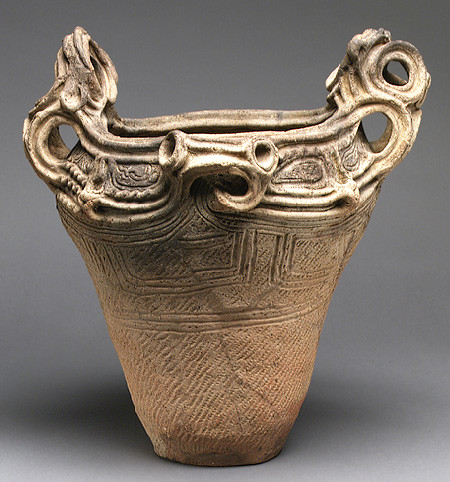
While I did not draw inspiration directly from the ancient Jōmon pottery, I find it intriguing that, when given the opportunity, I had the same desire to impress rope patterns into wet clay as did humans who lived over 15,000 years ago. In a very similar (if not identical) manner, we chose to use a “regular” object to create texture and decoration on our pottery, to make more beautiful a functional object. What does that say about me? What does that say about the Jōmon people?
Perhaps we have not changed so much…
|
|
|
|
|
|
|
|
|
|
|
|
Introducing… the Rope Series
|
|
|
|
For some time now I’ve been meaning to introduce some of the various elements and themes in my work. It’s a new year, so I’m gonna go ahead and get started on that. First up, Rope!

The blue bean studio Rope It In series is a play on the rope texture and an exploration of connection and the tie that binds.
When I first started trying various items to create texture, I found myself being drawn immediately to the rope because its texture is at once recognizable, and its form is easily manipulated and is full of potential. There is, however, a slightly deeper reason for my choosing to use the rope for my work.
A rope is made up of many strands. It is a simple everyday object that has varied, and sometimes essential, uses. That is, the rope reminds me that while we, as individuals, may be ordinary strands or threads, many individuals can be woven together to become a strong cord or community that can carry a heavy load or perform a greater function.
Most of the pieces in this series are hand built from stoneware clay and decorated in a clean color palette that brings to mind the beach and the ocean. The texture is simple and minimal. The designs are usually unplanned and organic. At times the lines intersect one another, sometimes they don’t. On occasion, the lines come together to connect or to form a recognizable shape.
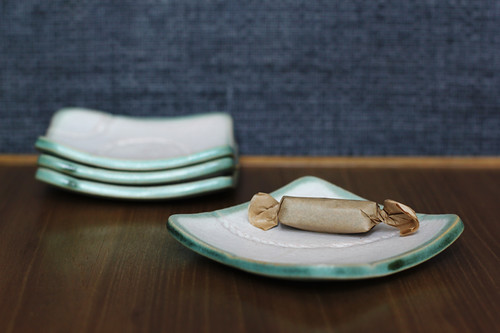
These Rope series ring dishes are currently available on Etsy.
As I love experimenting with texture, this series is particularly fun for me.
|
|
|
|
|
|
|
|
|
|
|
|
Two.O.One.Four.
|
|
|
|
It’s been a week since we all said our goodbyes to 2013. For me, last year was one of big changes and new beginnings. I had declared it the year of Creativity in my non-specific way of making a resolution. At the time, I had very little idea of what a year of Creativity would look like and I had no specific plan to implement. I later discovered that even one little word can have the power to shift us and move us in different ways along our journey, even when we’re not consciously allowing it to.

I like this idea of being unintentionally intentional, of allowing a word to permeate life in a way that we can’t fully control. So this morning as I was thinking through my day in bed I decided that I would declare this a year of (insert new word here). I went ahead and picked the first word that came to my head: Growth. Not sure why it was the first and only word that my brain could conjure up in my groggy state, but perhaps my subconscious is trying to tell me something.
The year of Growth. Growth is a good word. It is development. It implies gradual change (in contrast to the big transitions that we experienced last year).
I would love to see growth in many aspects of my life, but perhaps what is most relevant on this forum is development in the creative realm. There are definitely some specific things I can work on, like continuing to improve my throwing and hand building skills in ceramics, or getting more familiar with my new DSLR so I can take photos with greater ease. In other respects, the idea of creative development is rather vague — it could involve exploring different ways of expression, being open to other artistic influences, or finding my creative voice (whatever that means — I haven’t figured it out yet but have been told that it is something we have to constantly work on). I say let’s give it some time and see what sprouts out of this year of Growth.
At the end of the day, it’s all about making 2014 count.
|
|
|
|
|
|
|
|
|
|
|
|
  |
|
|

